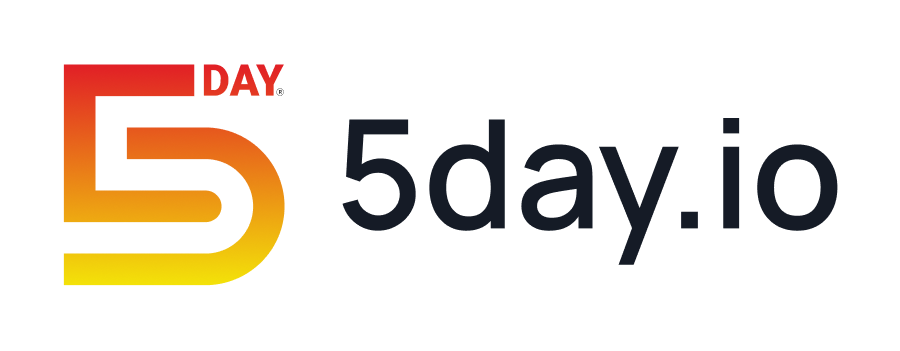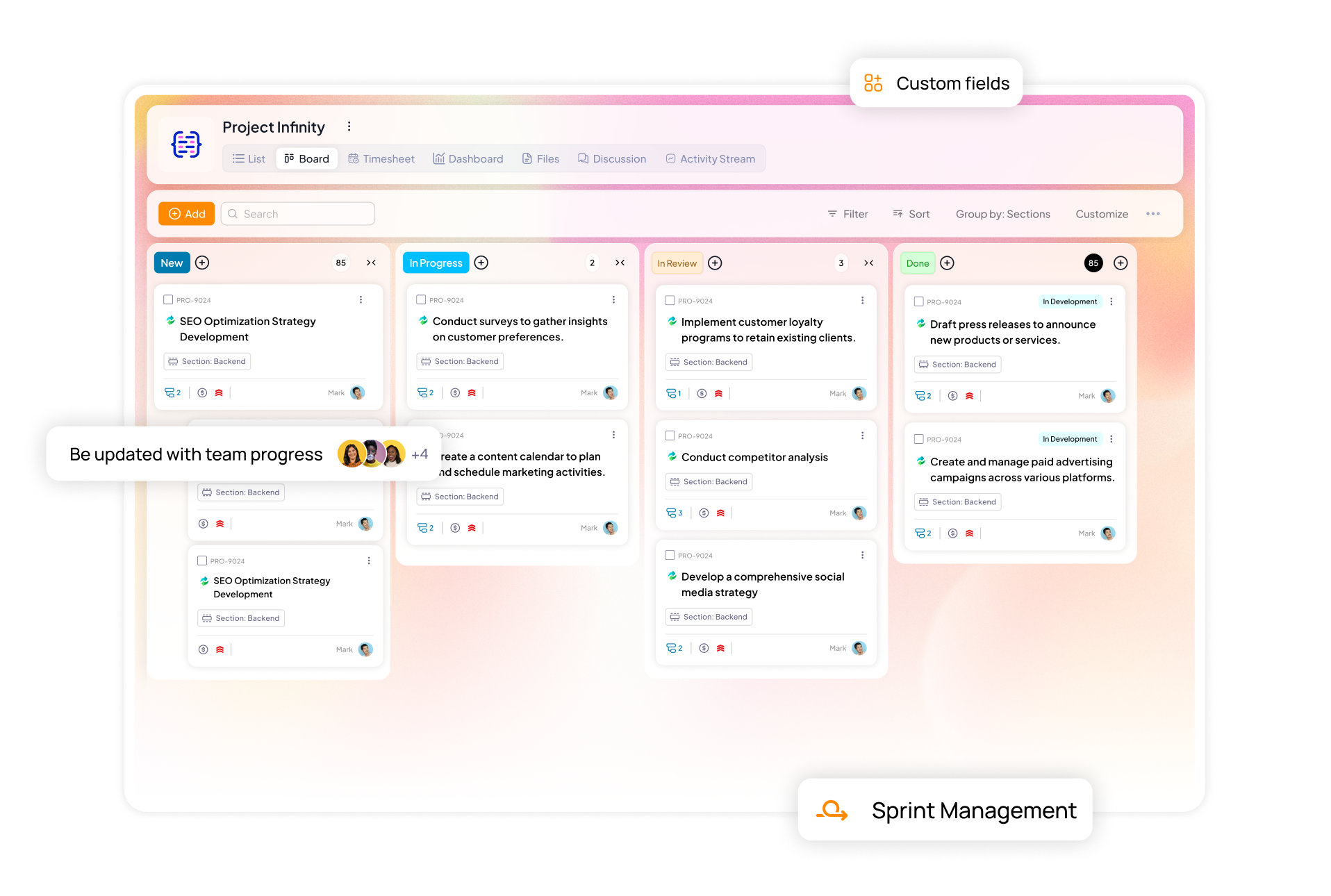There’s a quiet kind of magic that happens when creatives are supported just right.
But behind every inspired deliverable is something much less glamorous. A project management methodology and system that keeps your workflows in a loop.
The truth is that creativity doesn’t happen in a vacuum. It needs timelines, clarity, space to experiment, and a team lead who knows how to protect that process without dimming its spark. And yet, managing creatives can feel like walking a tightrope. Too much structure, and you suffocate the ideas. Too little, and the work spins out of control.
This article is for the ones trying to find that balance.
How do creatives work an agency setting?
Andrew Huberman, a neurobiology professor at Stanford says, “The most creative acts reveal to us how the world is in the most delightful way as possible.” Creative work is creative expression, and although done for remuneration on behalf of a marketing agency, it’s still deeply intimate and a part of the creative’s self-expression.
Just like how an idea is born and an artist gives it shape, a creative does too.
Although the creative project management differs from agency to agency, creatives everywhere go through roughly the same process. It starts from getting the brief intake/kickoff, ideation and concept development, first draft followed by internal reviews, client presentations and iterations, final delivery, post-mortem learning sessions (the best teams become the best by having this stage in their process).
If you’ve managed non-creative projects before, managing creative teams can feel drawn-out and overwhelming. But understanding the core of how creatives work can simplify the process, and help you leverage it to your advantage.
Understanding creative project management
Let’s go over the creative process in detail, to see how each stage is deeply intertwined with the rest of the process.
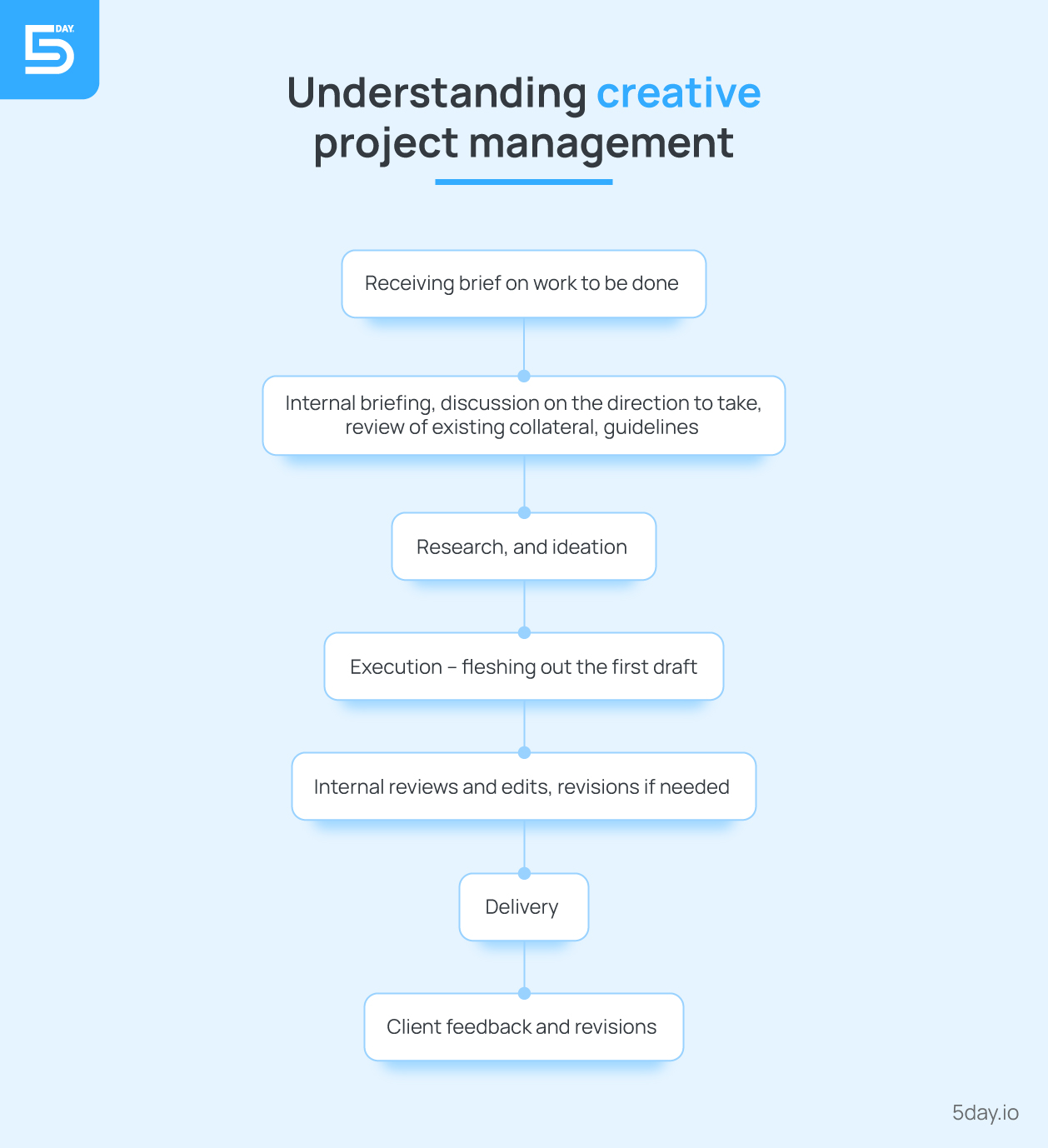
Project management for creative teams is about knowing that the best ideas often emerge in unpredictable bursts and that behind every piece of content or design lies someone pouring a little bit of themselves into it.
It all begins with the brief, which is more than a checklist, but a clear, unambiguous reflection of what the client wants, in terms the creatives understand. It gives your creatives enough direction to feel grounded, yet enough freedom to play.
Creatives absorb everything — the brand, the problem, the audience, the hidden emotion behind every message, research inspiration, connect dots you never knew existed, and piece together the creative output bit by bit.
What comes next is the shaping. Internal reviews, feedback, collaboration. Not every idea makes it. Not every draft shines. But with the right guidance, with trust and mutual respect, the team iterates and improves until the work feels just right.
Then, finally, the delivery. You get feedback from multiple client POCs, you consolidate them and implement them right to bring out the best output they have ever seen.
Through all these stages, you, as a project manager front the process, take the heat, gather insights and disseminate it throughout the team, juggle multiple types of creatives (designers, writers, video editors, and more), ensure everyone is aware of tasks at hand, what is expected of them, and when.
You’re the one who listens between the lines, who protects space for creativity to thrive, who makes sure no one burns out, and everyone feels seen. You carry both the pressure of the client and the pulse of the creative team and somehow keep it all in motion.
Major bottlenecks and challenges in managing creative project management
Even in projects involving very clearly defined scope, project milestones and objectified metrics, there’s always room for ambiguity, a person perceiving something in a whole other light. Given how deeply subjective creative products are, if you don’t conceive it right from the get-go, you’re sure to be faced with surprises at the end. And that’s the nightmare of every project manager. We’re not going to let that happen to you.
Process & planning challenges
A common issue project managers are tired of facing daily is clients going back on their word on what was agreed as project scope. A case study suddenly includes the landing page design, copy, the introductory text to go with it on the PDF, as a lead magnet.
Similarly, a client giving a few headers as brief and asking to flesh out an entire thought leadership piece without deep insights on what ‘exactly’ a thought leadership post looks like for them. You’re experienced, yes, but you aren’t a mind-reader. If clients assume you should know their unique POV already, you’re left with an ambiguous brief that’s likely to have multiple revisions.
Some clients, especially the ones who aren’t directly involved in content production or marketing many times think content is just ‘text on a page’, and design is just ‘something you throw onto Canva’. The amount of legwork that goes on before a word is written or a font is selected is severely underestimated. If you promise a timeline without asking your team on the effort it takes, you’re going to be in hot water.
Team & collaboration issues
The writer gives you the explainer video script, a designer to create a storyboard, a video editor to change it into a captivating video, and a voiceover artist to bring a human element to it. It takes a village to produce any creative output. If your team is scattered, communicates on different channels, and has no common thread, the collaborative exercise can quickly escalate into a competition/blame game.
This is worse if a few teammates work with you in person and a few people work remotely. Getting them together on the same page is a herculean task, without a proper system in place.
The writer may have had an aha moment when writing the script. If the designer says it must be rewritten, or it just doesn’t feel right, it may cause a rift. If the video editor asks the writer to cut down the text and reduce it to barebones, the writer may feel it’ll rip emotion out of the copy. This back and forth could extend timelines and create dependencies for others further along the creative process.
Similarly, everyone in a team could add suggestions and say, ‘This is my two cents”, but if no one puts their foot down and says, ‘This is final’, the output won’t make it to the client’s inbox at the right time.
Creative and ideation bottlenecks
Creative blocks are real. And they don’t care how experienced you are or how close your deadline is.
Then there’s the other extreme, when there are too many ideas on the table. Everyone’s excited, tossing brilliant concepts left and right. But without a strong filter or a clear direction, all those ideas start clashing. Every creative wants to push the boundaries, try something bold, something that hasn’t been done before. But with a client’s ultra-specific guidelines, timeline, budget, project phases, and platform limitations, you’d basically be flying inside a cage.
One other notorious thing creatives are guilty of is perfectionism. No amount of editing, or polishing can satiate their need for ‘more and better’. This can hinder delivery.
Performance and output issues
Some days, a campaign lands so well it gets shared across the team Slack with fire emojis. Other days, you wonder if the same team even worked on it. Unlike a task list or a spreadsheet, creative brilliance can’t be turned on with a switch. But for clients and stakeholders, that inconsistency can raise eyebrows and lead to friction.
Without clear KPIs, success becomes subjective, and that’s frustrating for both the creators and the managers trying to track performance.
Add to this the chaos of poor version control. You’ve got five versions of the same file floating around in emails, Slack threads, and cloud folders. No one’s sure which one is final. Someone edits version 3 while feedback is being collected on version 5. Suddenly, people are working in silos, assets are overwritten, and final delivery gets delayed.
Tips for managing design and content teams and overcoming challenges in creative project management
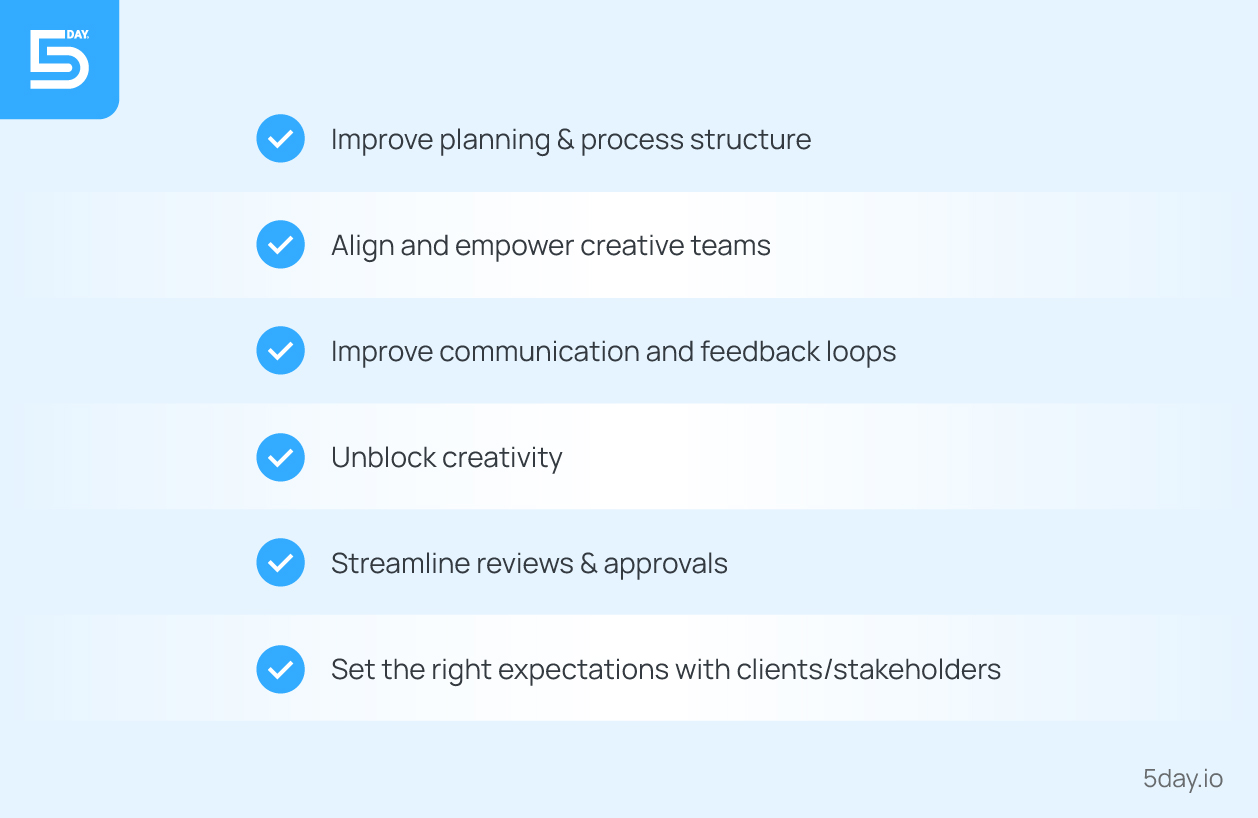
As project manager, you are the Avenger helping creatives do the best they can. Here’s what you can do to defend your team’s bandwidth, give them the space to bring out their genius, have their back, and make sure everyone benefits. This is your time to be a superhero, and we’ll show you how.
Improve planning & process structure
No task comes in without adapting itself to the many custom brief templates you have in place. Nail down scope, goals, timelines, deliverables, and success metrics right when the brief template is filled. When anything seems vague in your brief, you hop on a call with the client POC to help brainstorm and bring out exactly what they have in mind and document the signed-off brief. This secures your team’s bandwidth and draws a tangible boundary.
If you’re taking on a massive project, before you begin break it down into sprints under the agile methodology, or short work bouts. You can measure every bout effectively. Everyone has responsibilities in every sprint, and together you move the ball to the next stage.
Align and empower creative teams
If you’re managing different creatives in the same team, who should take a call on the design? Who is to decide which CTA works best? Who finalizes the final output? Draw up a chain of authority for the process and decide who takes what decisions. Anything related to copy? The copywriter decides. Need to increase keyword density? The editor takes a call.
No more transitions can be included? The video editor’s call is final. Instead of overlapping roles or stepping on each other’s toes, the team operates like a well-oiled creative machine.
Your duty doesn’t stop when you assign responsibilities, you must live it. Give leads the space to come up with solutions and trust their creative instinct. Arrange a recurring check-in meeting for everyone to stay aligned. Without those touchpoints, the over-communicators will overshare, and the quiet thinkers won’t speak up until something’s gone sideways.
Improve communication and feedback loops
One channel to give and take feedback and messages to clients, partners, and creatives – just about everyone else relevant to the project. Maintain every file centrally, so anyone who’s newly onboarded onto the project immediately gets wind of what’s been happening.
Another crucial action for you to take as your team’s superhero, is to set standards on how to give feedback when managing content and design teams. Set a template, or parameters for feedback on any creative piece. No vague ‘Can do better’, or ‘Doesn’t sound like us”, or “Can you make this pop?”. Every piece must be reviewed critically, and clear, detailed reasoning given for every comment made. That’s how creatives know exactly which layer to peel and change.
Unblock creativity
There’s a misconception that detailed briefs kill creativity. The opposite is true. Not having one leaves you fleeting with the wind. Having one shows you which way to fly, and not high you can reach.
Even your most trusted writers who hand you drafts in impossibly short timelines need a breather from time to time and can’t bring themselves to pen down another word. When burdened with another brief at this time, they may burn out trying to meet your standards or simply pass off an acceptable work as their best for the time-being.
No one wins in these scenarios. Understanding creatives’ downtimes, capacity, and breaks is crucial if you want them doing their best for you in the long run. Ask your freelancers’ capacity before you promise a deadline.
Want to come up with a plan based on your client’s brief? Allow your creative team some time to whip up something delicious for you. Encourage your teams to have idea-sparring sessions and idea-dump sessions. Once all possible ideas related to that project are out, step in and choose the ones that make most sense to your creative project.
Streamline reviews & approvals
It’s very common to see a design, or any creative product being approved by ten different stakeholders, most of them from unrelated functions, and the final version waiting to be finalized because a few approvers haven’t seen it yet. The project stalls, other stages down the line are affected. Suddenly when approvals come through, all other stages are rushed, and quality takes a big hit.
Only bring in the most relevant people for feedback and assign timelines and feedback framework to them. Hold them accountable and make the project pipeline visible to them so they can see who is holding up progress.
Set the right expectations with clients/stakeholders
What goes on behind creating a logo, or what constitutes a solid blog, people involved in the process know. But others, in adjacent functions don’t necessarily have to. Instead of being considered tardy for a major rework, if you set expectations on output and revision processes look like, you save your team from unnecessary blame-game.
If your designer has gone through 15 variations to get to the final logo, show your client the behind-the-scenes work to highlight your thoroughness. When setting deadlines and briefing about your project management process, converse with them on what a realistic timeline looks for the effort involved. Help them understand how a well-crafted headline might go through 10 different versions before it feels just right.
Use visual aids like mockups, wireframes, or rough drafts to guide their feedback. It’s hard for clients to visualize from thin air. It’s okay to say no to endless revisions or random “quick fixes.” Those quick asks tend to pile up, break flow, and disrupt schedules. Protect your creatives’ time and energy by putting revision limits in place. Push back client’s unreasonable requests, whenever necessary.
Case studies
A project manager-cum-firefighter

Venkatesh Durgam, Senior Enterprise Project Manager at Pepper Content, an AI-powered content marketing agency talks about his routine at work at the agency, “I start by looking at accounts that need attention, accounts at a critical stage. I look at the tasks on those accounts first, ensure the necessary communication goes out to the creators regarding their submissions, or assign new tasks if needed. That’s the approach I follow critical accounts first, followed by the less critical ones.”
When asked about how he coordinates with their creatives, Venkatesh says, “We work with a lot of freelancers. We use WhatsApp extensively, and also calls, for communication with freelancers (since they’re not on Slack).
Slack is used for internal communication. We also have our own project management tool. We use that to assign tasks. Once a task is assigned, we also message the creator on WhatsApp.
Once a creative is onboarded, our Managing Editor gives them a briefing, client expectations, a little background on how our platform works. We also provide training videos on how to use our platform. Once onboarded, they receive links to those resources.
Every task comes with client-specific guidelines (which are standardized). In some cases, we also include specific briefs. Writers follow the brief, write the article → it goes to the editor → then to the Managing Editor (ME). Even after editing, if the ME thinks changes are needed, the article is sent back to the writer with feedback. It’s an iterative process, based on feedback and collaboration.”
We asked him how he approaches time-sensitive, intensive projects that need all hands-on deck, Venkatesh says how he handles it. He remarks, “When we work with clients on complex topics (e.g., blogs, books), we first identify the right writer based on subject matter familiarity. After receiving the topic, we get on a call with the client to understand it in detail.
If there are any delays (e.g., waiting for expert input), we still have some buffer and negotiate extensions if needed. For non-negotiable deadlines (e.g., Congress presentation), we communicate clearly:
“We will do our best, but since the delivery is rushed, the output might not be 100% ideal.”
We explain that research needs time, and if there’s no time to do it properly, it’s better to set that expectation upfront.”
From the lens of a creative

Manya Jain, freelance content writer working with Pepper Content opens about her experience working at an agency that makes working easier than ever. She says, “When I was onboarded, I had introductory calls, we were told what to expect, what not to expect, how to go about it, it’s like, it’s like every agency has their own organized process to walk their writers through how to get started with a new project, especially when they’re so new and raw.
So, with my current agency, it was a very sweet spot between hand holding you through your first few articles and letting you take the lead and bring in your own flavor, I really appreciate that they do give us the creative freedom I really appreciate that.”
“We use an internal project management ecosystem, and every day I log in I see upcoming deadlines, delays, revisions and reviews status. For each task we get briefs with all necessary details. If we miss a deadline or get an extension, we get an email notification.
If I want to take some creative liberty, I can.
We were working on a piece and I thought I could bring in a more data driven approach to the content, but that meant tweaking the given outline a bit I picked my editor, I spoke to them, I ran them through my idea, through my vision and they were very impressed and okay with the approach that I wanted to take. “
She went on to say, “The agencies I worked with before didn’t have a good project management system before. One thing I’ve always disliked about working with agencies is how they often fail to clearly communicate revision policies in the contract. With this platform, it’s different, you’re notified promptly, and everything moves swiftly.
But with agencies, revisions can drag on for months.
Once, I worked on a blog. Three months after submitting a blog, they suddenly came back with revision requests, not because of my writing, but because they had misunderstood the brief. I had written exactly what was asked of me, even flagging at the time that something didn’t seem quite right. But they insisted the brief was correct.
Now, three months later, they wanted me to rewrite the entire article, without any extra compensation, without an apology, and without even acknowledging that their team had shared the wrong brief. Such experiences taint the experience of a creative.”
What does a super useful project management tool look like for creative project management?
Armed with the best creative project management strategies in place, you’re now ready to set a smooth workflow and ease your team into it. But to make sure it stays in place, and is used right, you need an intuitive, intelligent tool.
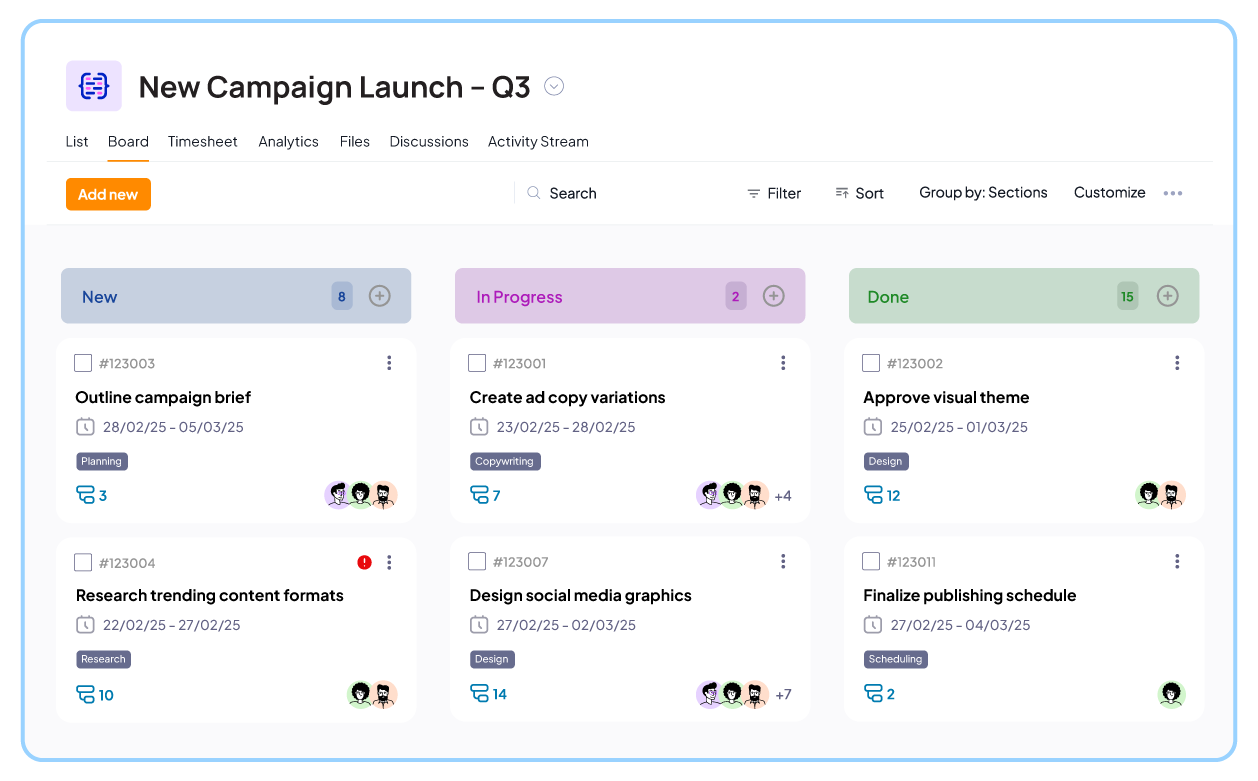
It’ll be your central repository, one stop shop for all external and internal project-level discussions, status updates, deadline changes, feedback rounds and brief sharing. For a tool with such responsibilities, a few features are crucial:
- Flexibility, because creative processes evolve
- Quality visuals because creatives think in mood boards
- Smooth collaboration because the creative process improves with collaboration
- Deadline-driven but empathetic because creativity needs room to grow
5day.io is a creative project management software that has all of these and tailored by those in the field for long.
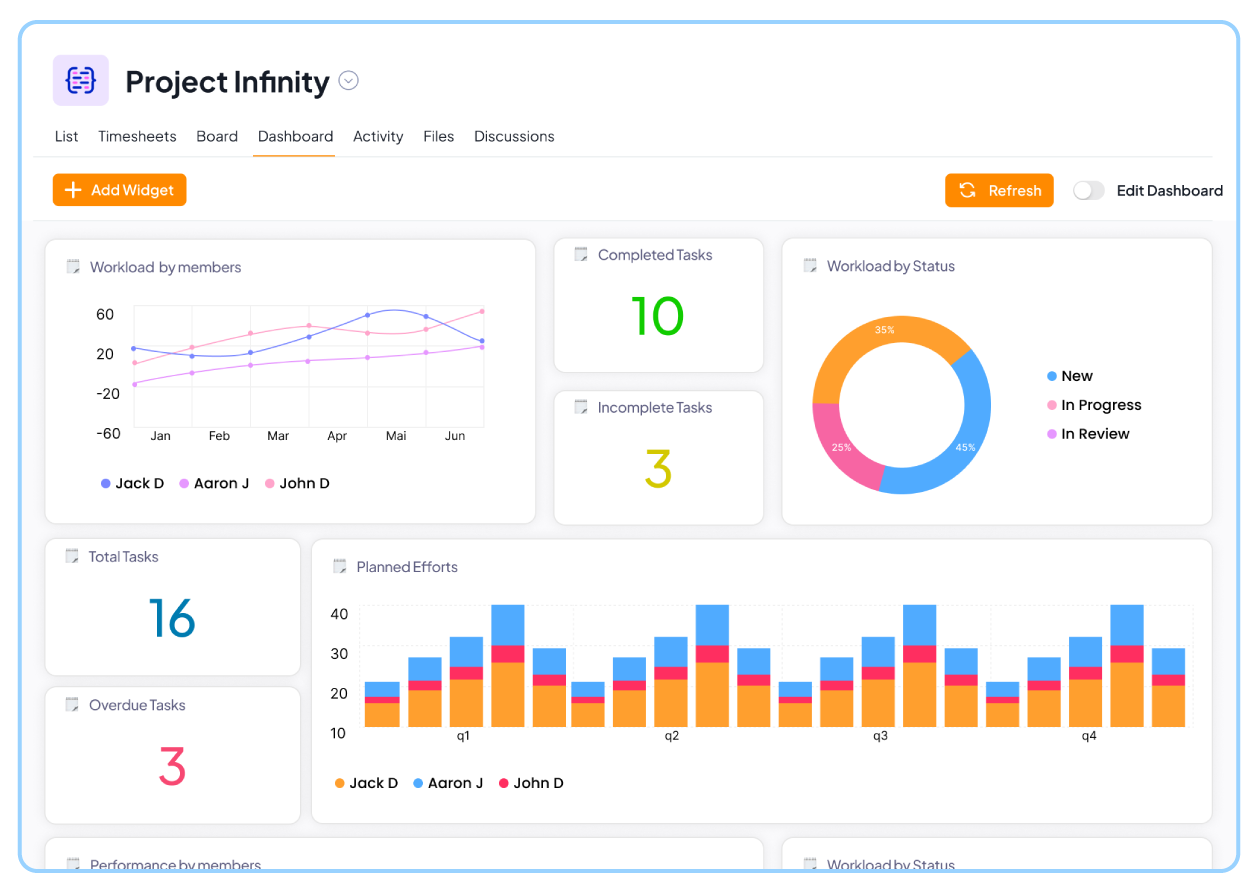
- 5day.io helps you break down large creative projects into micro-deadlines that feel human.
- The tool keeps the brief, the task, the conversation, and the file all in one place. No more digging through old threads or wondering which doc is the final one.
- Everything is attached to the task, so when you sit down to work, you have what you need, instantly.
- The platform solves any confusion by keeping all comments, and conversations linked directly to the task or file. There’s no confusion.
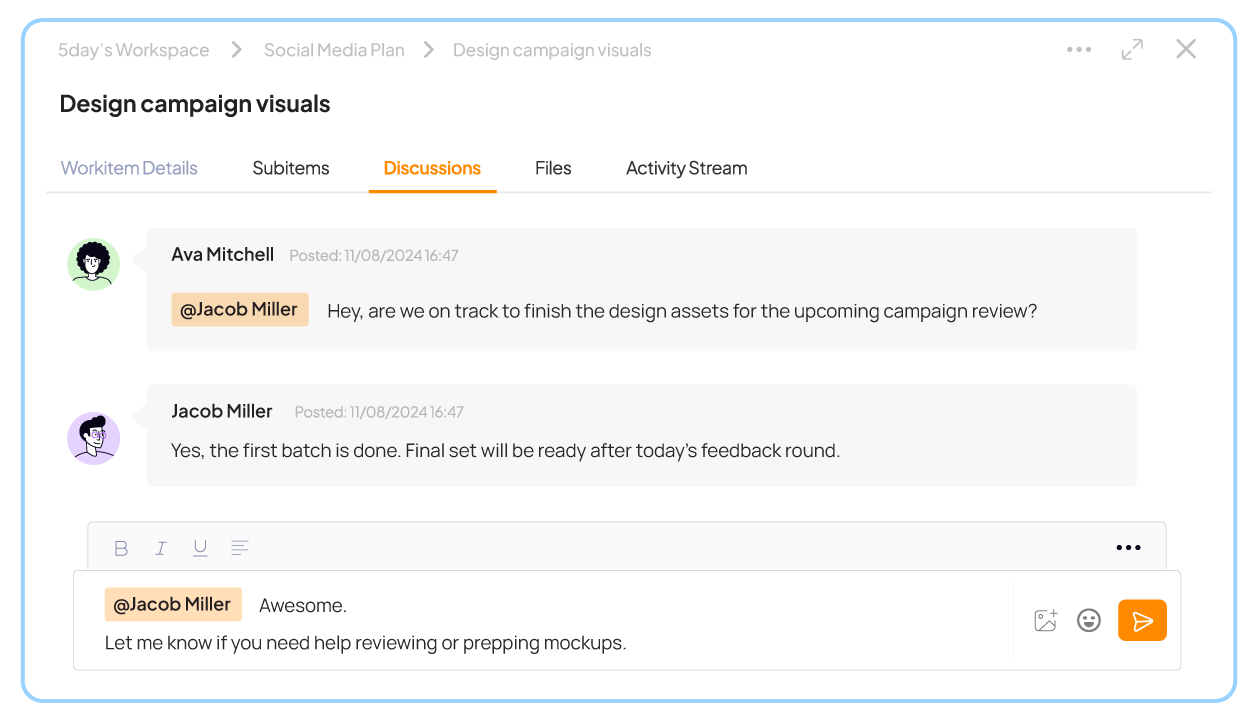
- Does your agency have a unique project management methodology, and not the conventional waterfall method? Customize your own workflows and templates on 5day.io now.
- The tool also lets you share clean, visual timelines, show progress updates without scrambling, and respond to feedback faster (because the whole team is in sync).
- 5day.io helps teams manage bandwidth better. You can see who’s overloaded, who’s got room to help, and where projects are getting stuck.
Conclusion
Whether you’re juggling multiple client campaigns or building a brand in-house, the way you manage your creative team has a direct impact on the quality of the work, and the wellbeing of the people behind it.
So, invest in the right tools. Set honest timelines. Make space for collaboration and iteration. Use a reliable, simple to use tool creative project management software like 5day.io. Sign up for our 30 days free trial today.
